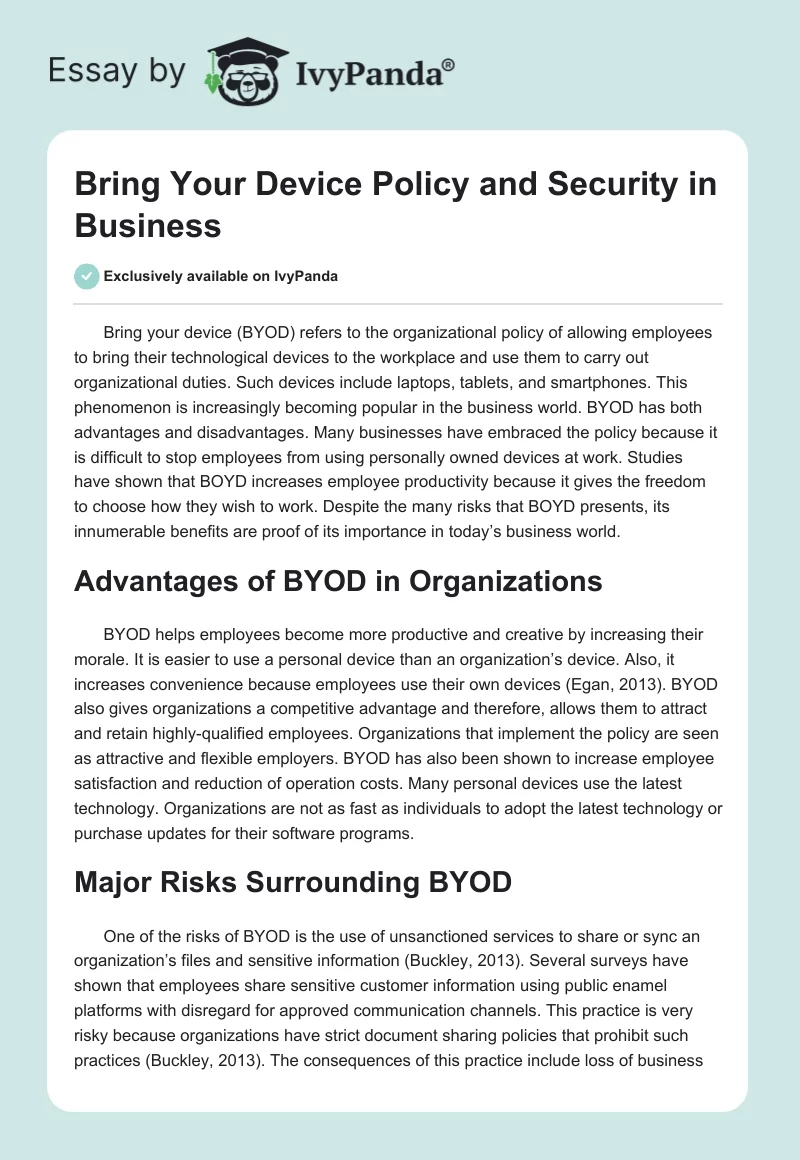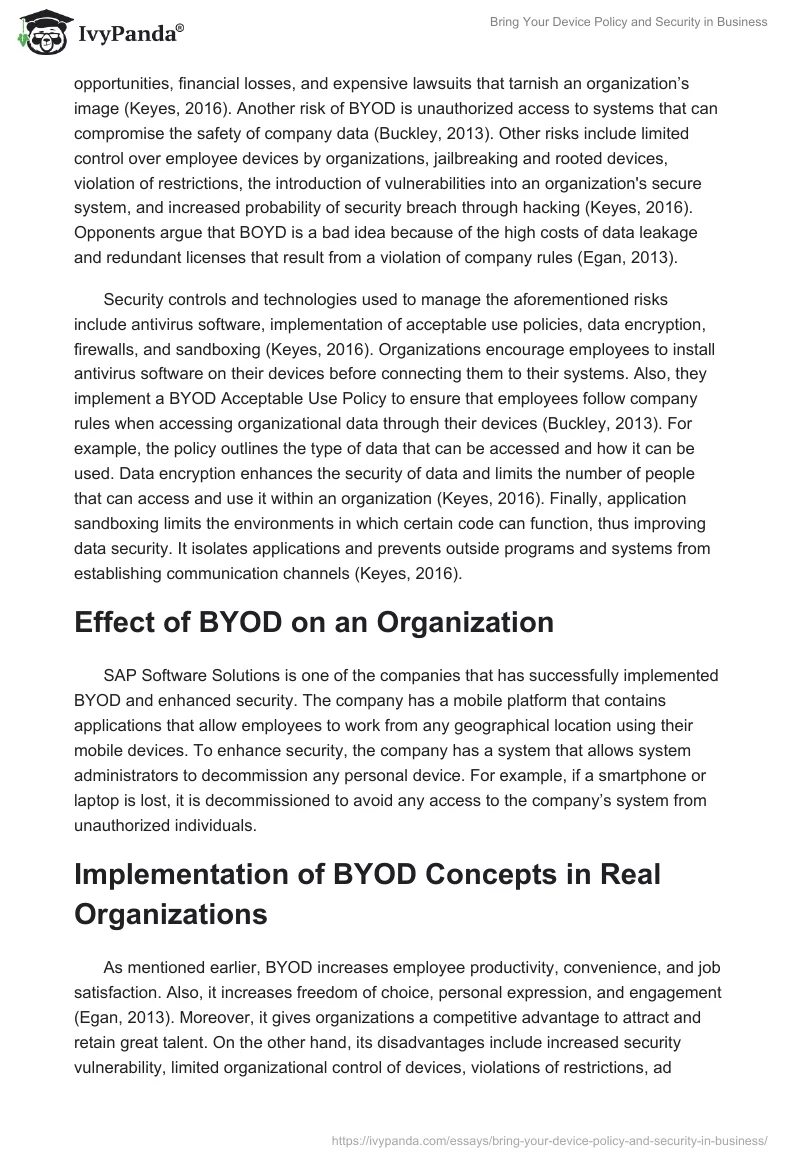Bring your device (BYOD) refers to the organizational policy of allowing employees to bring their technological devices to the workplace and use them to carry out organizational duties. Such devices include laptops, tablets, and smartphones. This phenomenon is increasingly becoming popular in the business world. BYOD has both advantages and disadvantages. Many businesses have embraced the policy because it is difficult to stop employees from using personally owned devices at work. Studies have shown that BOYD increases employee productivity because it gives the freedom to choose how they wish to work. Despite the many risks that BOYD presents, its innumerable benefits are proof of its importance in today’s business world.
Advantages of BYOD in Organizations
BYOD helps employees become more productive and creative by increasing their morale. It is easier to use a personal device than an organization’s device. Also, it increases convenience because employees use their own devices (Egan, 2013). BYOD also gives organizations a competitive advantage and therefore, allows them to attract and retain highly-qualified employees. Organizations that implement the policy are seen as attractive and flexible employers. BYOD has also been shown to increase employee satisfaction and reduction of operation costs. Many personal devices use the latest technology. Organizations are not as fast as individuals to adopt the latest technology or purchase updates for their software programs.
Major Risks Surrounding BYOD
One of the risks of BYOD is the use of unsanctioned services to share or sync an organization’s files and sensitive information (Buckley, 2013). Several surveys have shown that employees share sensitive customer information using public enamel platforms with disregard for approved communication channels. This practice is very risky because organizations have strict document sharing policies that prohibit such practices (Buckley, 2013). The consequences of this practice include loss of business opportunities, financial losses, and expensive lawsuits that tarnish an organization’s image (Keyes, 2016). Another risk of BYOD is unauthorized access to systems that can compromise the safety of company data (Buckley, 2013). Other risks include limited control over employee devices by organizations, jailbreaking and rooted devices, violation of restrictions, the introduction of vulnerabilities into an organization’s secure system, and increased probability of security breach through hacking (Keyes, 2016). Opponents argue that BOYD is a bad idea because of the high costs of data leakage and redundant licenses that result from a violation of company rules (Egan, 2013).
Security controls and technologies used to manage the aforementioned risks include antivirus software, implementation of acceptable use policies, data encryption, firewalls, and sandboxing (Keyes, 2016). Organizations encourage employees to install antivirus software on their devices before connecting them to their systems. Also, they implement a BYOD Acceptable Use Policy to ensure that employees follow company rules when accessing organizational data through their devices (Buckley, 2013). For example, the policy outlines the type of data that can be accessed and how it can be used. Data encryption enhances the security of data and limits the number of people that can access and use it within an organization (Keyes, 2016). Finally, application sandboxing limits the environments in which certain code can function, thus improving data security. It isolates applications and prevents outside programs and systems from establishing communication channels (Keyes, 2016).
Effect of BYOD on an Organization
SAP Software Solutions is one of the companies that has successfully implemented BYOD and enhanced security. The company has a mobile platform that contains applications that allow employees to work from any geographical location using their mobile devices. To enhance security, the company has a system that allows system administrators to decommission any personal device. For example, if a smartphone or laptop is lost, it is decommissioned to avoid any access to the company’s system from unauthorized individuals.
Implementation of BYOD Concepts in Real Organizations
As mentioned earlier, BYOD increases employee productivity, convenience, and job satisfaction. Also, it increases freedom of choice, personal expression, and engagement (Egan, 2013). Moreover, it gives organizations a competitive advantage to attract and retain great talent. On the other hand, its disadvantages include increased security vulnerability, limited organizational control of devices, violations of restrictions, ad introduction of vulnerabilities. I would consider implementing BOYD concepts in a real organization because the benefits outweigh the risks. Also, the implementation of security measures and putting sufficient protections and governance practices in place can be used to mitigate the risks (Keyes, 2016). Technological devices have become inevitable components of professional and personal lives. Therefore, it would be beneficial to allow employees to carry their technological devices to work and use them to access and process data.
Conclusion
BYOD is a phenomenon that many businesses and corporations are embracing to improve employee productivity, job satisfaction, and retention rates. It involves allowing employees to use their devices at work to carry out organization duties. The BOYD policy has elicited heated debate because opponents argue that it encourages the introduction of security vulnerabilities in systems due to violation of company restrictions. However, they fail to consider its innumerable benefits. Many companies have benefited from implementing BOYD policies and putting security measures in place to ensure that employees do not compromise the security of organizational data.
References
Buckley, C. (2013). The dark side of BYOD: Exploring new mobile and cloud platforms without a governance strategy can have consequences. TechRepublic. Web.
Egan, B. (2013). BYOD as we know it is dead. Forbes. Web.
Keyes, J. (2016). Bring your own device (BYOD) survival guide. New York, NY: CRC Press.


